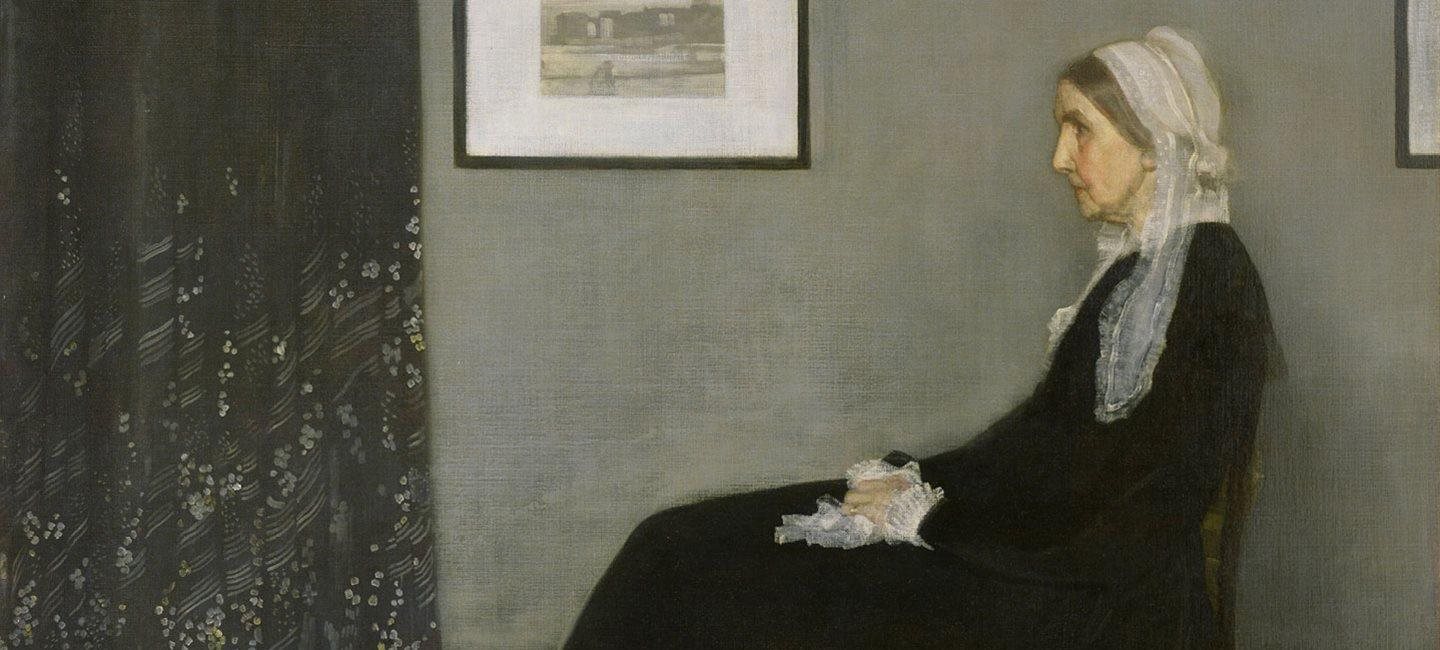
JULY 4–SEPTEMBER 27, 2015
ABOUT THE EXHIBITION
James McNeill Whistler’s most famous work, Arrangement in Grey and Black, No. 1 (Portrait of the Artist’s Mother), is known to many as Whistler’s Mother. The painting serves as the centerpiece of the exhibition Whistler’s Mother: Grey, Black, and White, which also features a selection of Whistler’s prints and drawings, Japanese woodblock prints that inspired the artist, and ephemera that explore the image’s role in popular culture.
Whistler’s Mother presents works from the Lunder Collection of James McNeill Whistler at the Colby College Museum of Art as well as from the Clark’s permanent collection. The exhibition is divided among four galleries. The first is dedicated to Arrangement in Grey and Black, No. 1 and Black Lion Wharf, the framed print depicted hanging on the wall behind the artist’s mother in the painting. The second and third galleries present a collection of prints and lithographs, and the fourth shows a timeline of the painting’s legacy in the American consciousness.
Whistler’s Mother: Grey, Black, and White is presented in collaboration with the Colby College Museum of Art and the Lunder Consortium for Whistler Studies. The exhibition is generously supported by a grant from The Lunder Foundation, by Katherine and Frank Martucci, and by an indemnity from the Federal Council on the Arts and the Humanities.
LANDSCAPE AND THE RIVER THAMES
Arrangement in Grey and Black, No. 1 includes several elements that engaged Whistler during his years in London: the river Thames, night scenes, and Japanese art. The artist’s desire to focus on form and color rather than narrative developed during the 1860s and ’70s.
Whistler made many images of the Thames, including paintings and prints that he called “nocturnes,” and a suite of etchings produced between 1859 and 1871 titled The Thames Set. Whistler’s use of the terms “arrangement,” “symphony,” and “nocturne” in his titles reflects his interest in the musical notions of harmony and balance. As the artist explained, “By using the word ‘nocturne’ I wished to indicate an artistic interest alone, divesting the picture of any outside anecdotal interest which might have been otherwise attached to it. A nocturne is an arrangement of line, form, and colour first.”
Whistler’s compositional experiments also drew inspiration from Japanese art and design. The interior space depicted in Arrangement in Grey and Black, No. 1 and the radical cropping and foreshortening that can be found in many of Whistler’s etchings derive to some extent from similar compositional techniques that appear in Hiroshige’s color woodblock prints, which Whistler collected. More directly, the black curtain visible in Arrangement in Grey and Black, No. 1 is of Japanese design.
PORTRAIT PRINTS
Arrangement in Grey and Black, No. 1 is Whistler’s most famous painted portrait, but he made hundreds of etched, lithographic, and drawn portraits of his family, friends, and patrons throughout his life. The etchings in the exhibition focus on the themes of youth and old age, Whistler’s interest in music and musical instruments, and genre portraits, some of which depict Parisian street types in an unidealized manner. Regardless of his subject, Whistler was concerned with capturing the essence of a particular sitter, be it their youthful innocence or their concentrated gaze while reading a book.
During the 1890s Whistler became particularly captivated by the printmaking process of lithography, using it to create silvery effects that resemble the tones of a graphite drawing. In these works, he would often place the figures in the center of the sheets of paper so that they appeared to float in space, allowing the spontaneity of the drawn marks to direct the viewers’ eyes to the subject.
